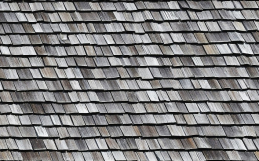When it comes to roofing, homeowners have a lot of options, but composition shingles are one of the most popular choices. Why? They are affordable, easy to find, and come in a wide variety of styles and colors to fit almost any home. But there’s another important factor to consider—are composition shingles fire-resistant?
This question is especially crucial if you live in an area prone to wildfires or if you just want to ensure your home is as safe as possible. In this blog, we’ll explore the fire resistance of composition shingles and how they compare to other roofing materials like metal, wood, and tile. We’ll also go over some additional measures you can take to protect your home from fire.
What Makes Composition Shingles Fire Resistant?
Composition shingles, also known as asphalt shingles, are a common choice for homeowners. These shingles are made from a mixture of materials, including asphalt, fiberglass, and sometimes mineral granules. One of the benefits of these shingles is that they can be fire-resistant. But how fire-resistant are they really?
The fire resistance of a roofing material is often measured by its fire rating. In the case of composition shingles, the most important ratings are Class A, Class B, and Class C. These ratings tell you how well the shingles can resist fire.
- Class A Fire Rating: Shingles with a Class A rating offer the highest level of fire protection. They can withstand severe exposure to fire, making them an excellent choice if you want to protect your home.
- Class B Fire Rating: These shingles can resist moderate exposure to fire. While not as strong as Class A, they still provide a reasonable level of protection.
- Class C Fire Rating: Class C shingles with this rating offer the least amount of fire protection. They can resist light exposure to fire, but they are not as reliable as Class A or B shingles.
Not all composition shingles are created equal, and not all of them have the same fire rating. If you’re considering these shingles for their fire-resistant properties, it’s important to check their rating. Additionally, the fire resistance of your roof isn’t just about the shingles themselves.
The underlayment, which is the layer of material between the roof deck and the shingles, plays a crucial role in resisting fire. Choosing a fire-resistant underlayment can enhance the overall fire protection of your roofing system.
The slope of your roof also matters. Steeper roofs are generally better at resisting fire because they allow burning embers to roll off more easily, while flatter roofs may hold onto embers longer, increasing the risk of fire. Ensuring your roofing system is properly installed and maintained is key to maximizing its fire-resistant properties.
How Do Composition Shingles Compare to Other Roofing Materials?
While composition shingles can offer good fire resistance, it’s essential to compare them to other roofing materials to understand how they stack up.
Metal Roofing
Metal roofing is known for being one of the most fire-resistant roofing materials available. Unlike wood, metal doesn’t burn, making it an excellent option if fire protection is a top priority. Most metal roofing materials have a Class A fire rating, which is the highest you can get.
Concrete and Clay Tiles
These materials are also highly fire-resistant. Like metal roofing, they generally carry a Class A fire rating. However, they are heavier and more expensive than composition shingles.
Wood Shingles and Wood Shake
These are made from natural wood, which is not naturally fire-resistant. But wood shakes can be treated with fire retardant to improve their fire resistance. Even then, they usually only reach a Class B or Class C fire rating, making them less effective at resisting fire compared to metal roofing or composition shingles with a Class A rating.
Slate Roof
Slate is another material with a high fire resistance rating. Like metal and tile, it is non-combustible and can achieve a Class A rating. Slate roofs can be quite heavy and expensive which may not be suitable for all homes. Make sure your structure meets building codes for the additional weight.
Each of these materials has its pros and cons, but if fire protection is your main concern, composition shingles with a Class A fire rating, metal roofing, and clay or concrete tiles are your best options.
Fire Resistance vs. Fire Retardancy: What’s the Difference?
 It’s easy to confuse fire resistance with fire retardancy, but they are not the same thing. Understanding the difference can help you make a better decision when choosing a roofing material.
It’s easy to confuse fire resistance with fire retardancy, but they are not the same thing. Understanding the difference can help you make a better decision when choosing a roofing material.
Fire Resistance
This term refers to a material’s ability to withstand fire and prevent it from spreading. Materials that are fire-resistant do not easily catch fire and can help prevent the spread of flames. For example, Class A-rated composition shingles are fire-resistant because they can withstand severe fire exposure without catching fire easily.
Fire Retardancy
Fire retardancy, on the other hand, refers to a material that has been treated with chemicals to reduce its flammability. For instance, wood shingles can be treated with fire retardant to make them less likely to catch fire, but they are not naturally fire-resistant. This treatment can help improve their fire rating, but they are still not as reliable as materials that are naturally fire-resistant, like metal or slate.
FAQs About Fire Resistant Roofing
What is a Class A fire rating?
A Class A fire rating is the highest fire resistance rating for roofing materials. It means the material can withstand severe exposure to fire without catching fire easily.
Can all composition shingles resist fire?
Not all composition shingles have the same fire resistance. Some may have a Class A rating, while others may have a Class B or C rating. It’s important to check the rating before purchasing.
Are wood shingles safe to use in areas prone to wildfires?
Wood shingles can be treated with fire retardants, but they are still not as fire-resistant as other materials like metal or composition shingles with a Class A rating.
Does the slope of my roof affect its fire resistance?
Yes, the slope of your roof can affect its ability to resist fire. Steeper roofs allow embers to roll off more easily, reducing the risk of a fire starting on the roof.
How often should I have my roof inspected?
It’s a good idea to have your roof inspected at least once a year, or after any major weather event, to ensure it remains in good condition and can resist fire.
Are you concerned about the fire resistance of your roof, especially now that the threat of wildfires is so high? Warner Roofing and Construction can help. We specialize in installing a wide variety of roofing systems, including composition shingles, metal roofing, and wood shake. Our team of experts can guide you in choosing the best fire-resistant materials for your home.
Contact us today to schedule a roof inspection or to learn more about how we can help you protect your home from fire.







